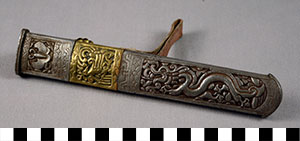Sheath
2012.10.0179B
Detailed Images
Basic Information
| Artifact Identification | Sheath (2012.10.0179B) |
|---|---|
| Classification/ Nomenclature |
|
| Artist/Maker | Unknown |
| Geographic Location | |
| Period | N/A |
| Date | Early 20th Century |
| Culture | Tibetan |
| Location | Not on Exhibit |
Physical Analysis
| Dimension 1 (Length) | 22.5 cm |
|---|---|
| Dimension 2 (Width) | 3.5 cm |
| Dimension 3 (Depth) | 3.07 cm |
| Weight | 410 g |
| Measuring Remarks | N/A |
| Materials | Metal--Brass, Metal--Iron |
| Manufacturing Processes | N/A |
Research Remarks
| Description | N/A |
|---|---|
| Published Description | Under Review |
| Bibliography | Altmann, Karin, Fabric of Life: Textile Arts in Bhutan—Culture, Tradition and Transformation, Walter de Gruyter GmbH & Co KG, 2016. |
Artifact History
| Credit Line/Dedication | Gift of Robert C. and Donna M. Spina Helmholz |
|---|---|
| Reproduction | N/A |
Contact
All information about our collection is constantly reviewed and updated. Please contact Dery Martínez-Bonilla, Registrar, if there is any information you are looking for that isn't currently online.
